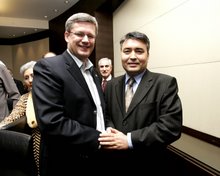Title World Directory of Minorities and Indigenous Peoples - China : Uyghurs
Publication Date July 2008
UNHCR Refworld, available at: http://www.unhcr.org/refworld/docid/49749d3c4b.html [accessed 31 March 2009]
World Directory of Minorities and Indigenous Peoples - China : Uyghurs
Updated July 2008
Profile
Uyghurs speak a south-eastern Turkic language and are thought to currently number around 8.6 million, though some groups assert that their numbers are much higher. They tend to be mainly concentrated in the north-western corner of China and, until recently, a substantial majority in the Xinjiang Uyghur Autonomous Region (XUAR). Most are Sunni Muslims. The Uyghurs are a majority in western XUAR and in the Turpan prefecture, while Han Chinese are the majority in most major cities and in the east and north. There are also Uyghurs found in Hunan province in south-central China.
Historical context
China's Uyghur minority are a remnant of the vast Uyghur Empire which stretched from the Caspian Sea to Manchuria in the eighth century, eventually to be overrun by other tribes in much of Central Asia.
During many centuries, various Uyghur, Mongol and Chinese regimes ruled the region. Much of what is today Xinjiang ('new frontier') was ruled by or owed allegiance to the Mongols from the thirteenth century. Various Uyghur and Mongol khanates exerted authority over different parts of the region, with the Manchu Qing Empire entering the area and controlling all of it by about the mid-eighteenth century. For a brief period after 1864, Xinjiang was to break away from the Qing Empire while China was weakened by other conflicts and unable to maintain its garrisons in the distant province. Chinese control was reasserted in 1877.
The end of the Qing Dynasty and the creation of the Republic of China in 1912 were followed by a period of weak central government control over Xinjiang. A rebellion in the 1930s (in reaction to a large degree to heavy taxes on Uyghurs to finance Han migration and settlement on some of the province's best agricultural land) resulted in the establishment of the first modern Uyghur state in 1933. The East Turkistan Republic was centred mainly in the southern region of Kashgar and Khotan. It survived only one year and returned to the control of the Han Chinese under warlord Sheng Shicai. Parts of northern Xinjiang were to form the second East Turkistan Republic between 1944 and 1949. The Uyghurs' taste of independence was brought to an end with the arrival of the People's Liberation Army in Xinjiang in 1949.
The region took its current shape as the Xinjiang Uyghur Autonomous Region on 1 October 1955. Tensions and resentment, despite some early idealistic moves that were receptive to the rights of nationalities, quickly increased when Chinese Communist authorities began to clearly favour Han Chinese. There were initial statements by the Communists criticizing past Han nationalism and promising that Xinjiang would remain in control of its nationalities, since they had a right of self-determination, but real power in the post-1955 XUAR appeared to be held in practice by the Han Chinese cadres.
While no segment of Chinese society escaped the effects of the Cultural Revolution and the Great Leap Forward, most accounts agree that the Uyghurs in Xinjiang appeared to be particularly targeted, with between 60,000 and 100,000 Uyghurs and Kazakhs fleeing the country after 1962 to avoid repression and famine.
Resentment of and resistance to government-supported migration or support of Han Chinese to the detriment of Uyghurs, restrictions on their religious and cultural practices, and loss of land have periodically caused eruptions of violence in the region. There were student demonstrations and riots in the 1980s linked to opposition to an announced expansion of Han migration and the Baren Township riot in 1990, where at least 50 people were killed (some reports claim there were hundreds) following a government decision to close down a local mosque. This subsequently led to a series of riots in other parts of Xinjiang.
Numerous bombing incidents in Xinjiang and Beijing itself – blamed on Uyghur extremists – occurred in 1997, as well as attacks against Chinese soldiers and officials. Widespread demonstrations and street fighting followed the arrest of suspected separatists during Ramadan.
The overall effect of the Communist Party of China's policies in the last six decades, one of the main sources of the tensions and resentment in the region, is unmistakable and stunning: the proportion of the Han Chinese population in Xinjiang has jumped from about 6 per cent in 1949 to much more than 40 per cent in 2004, with a massive influx of about 8 million Han Chinese – not counting soldiers and others on 'temporary contracts'. The capital of the province itself went from being a city where the Uyghurs were the clear majority (their proportion being about 80 per cent) to one where the Uyghurs have been almost completely displaced, and where it is now the Han Chinese who constitute about 80 per cent of the total population.
As the demographic weight of the Uyghurs is thus reduced, use of their language and the practice of other cultural and religious activities closely linked to Uyghur identity are being increasingly restricted by Chinese authorities who more and more openly espouse a pro-Han chauvinism. Schools and universities are increasingly being required to teach in Mandarin rather than Uyghur.
Current issues
The strategic position of Xinjiang and the potential for ethnic unrest translates into a high degree of control of the region and of the affairs of the Uyghur minority by central authorities. Decision-making is concentrated in the centrally appointed Party structure and in Beijing, thereby excluding ethnic Uyghurs. Two additional factors contribute to this configuration: the role of the Xinjiang Production and Construction Corps, directly under the State Council and virtually independent of the government; and the extremely limited power granted to national minorities, in particular Uyghurs, in the government and the Party – even compared to other national minority areas of China.
Until recently, the large number of Uyghurs (perhaps 8 million or so) constituted a substantial majority in Xinjiang, and legislation and regulations are supposed to guarantee them minority and language rights as well as prohibit discrimination. However, the control and role which one would expect the Uyghurs to be able to exercise over the operations of administrative units has been eroded or even eliminated in recent years, along with the language requirements for job opportunities within government offices and the language of education in schools.
Since the mid-1990s the gradual exclusion of Uyghurs from state-based employment – and the rising number of private jobs is stunning and statistically verifiable from a variety of sources. Reports in 2005 point out how Han Chinese are employed and ethnic Uyghurs kept out of new construction jobs, on road-building projects and oil and gas pipelines. While the Han Chinese have an unemployment rate of only about 1 per cent in Xinjiang, the rate among the Uyghurs is a staggering 70 per cent.
As with the Mongolian and Tibetan minorities, access to employment is increasingly a contentious issue for the Uyghur minority, and is seen as dependent on fluency in Mandarin, since state authorities in the region refuse to recognize any concrete entitlement to use of Uyghur beyond its use as a medium of education. The reduction of bilingual services provided by state authorities has resulted in the removing of bilingual employment opportunities, which would have meant the employment of more Uyghurs, whereas increased monolingual state operations have led to a much higher proportion of Han Chinese being preferred in almost all fields of employment. For example, in April 2005 the government announced that in southern Xinjiang, where the Uyghurs constitute over 95 per cent of the population, 500 out of 700 new civil service positions would be given to Han Chinese. At the same time, the Xinjiang Production and Construction Corps hired 9,000 Han Chinese from Gansu to work on its farms, rather than employ Uyghurs living nearby.
Even the few areas where use of Uyghur was associated with job opportunities – such as in education – have seen a rapid reduction since 2000. From the late 1980s, Chinese-language instruction became more prominent, whereas instruction in Uyghur began to be curtailed, sometimes through the process of merging Chinese and Uyghur schools with the unavoidable result that these schools would teach almost exclusively in Mandarin. Xinjiang University, initially established in 1949 as a bilingual (Uyghur/Mandarin) university has all but cast away instruction in Uyghur since 2002. Authorities have moved towards replacing Uyghur with Mandarin in almost all schools: schools in Artush, for example, began teaching all first grade elementary school classes exclusively in Mandarin Chinese in September 2006. The policy will apparently require that all primary and secondary schools teach exclusively in Mandarin by 2012. About 80 per cent of the population of Artush is Uyghur.
A continuing issue for the Uyghur minority is the role and dominating impact of the Xinjiang Production and Construction Corps – a body which is probably best described as an economic and semi-military quasi-state organization. Operating almost completely outside the control of the XUAR authorities since 1981, it has de facto administrative authority over a number of cities, settlements and farms all across Xinjiang. It has coordinated the settlement and employment of millions of Han Chinese in the area and continues to fulfil administrative functions such as health care, printed and electronic media and education for areas under its jurisdiction. This includes primary, secondary and tertiary education (with two universities, Shihezi University and Tarim University). It has control over 16 million mu (over 2.5 million acres) of farmland, representing about a third of the Xinjiang's arable land. Its operations are essentially exclusively in Mandarin, thus acting as an important agent in the sinicization of the XUAR, and of the growing exclusion and disempowerment of the Uyghur minority. This is part of an overt government policy of supporting massive Han migration into the region in order to weaken the demographic and political weight of the Uyghurs in Xinjiang – which is a dangerous source of frustration and resentment. Another issue that has emerged is the right of members of a minority to their name in their own language, which is protected under international law under the right to private and family life. A policy adopted in 2002 seems to require that Uyghur names be changed into Chinese pinyin.
A perhaps even more contentious issue involves the freedom of religion of Uyghurs and the crackdown by authorities in the name of security and the fight against terrorism and separatism. The religious activities of Muslims in Xinjiang are subjected to extensive controls and restrictions which are not applied to any other part of China: a special regulation of the XUAR effectively bans minors from participating in religious activities, resulting in authorities prohibiting teaching of Islam to school-age children. Though in theory applying to all religions in Xinjiang, reports in 2005 and 2006 seem to confirm that this regulation is applied more harshly to Uyghur Muslims. The ban has also been interpreted in some areas as prohibiting children from entering mosques, and has led to the confiscation and destruction of unapproved religious texts, and the censoring of imams' sermons. Any type of unsanctioned religious activity in Xinjiang risks much more serious consequences than in other parts of China, with the result that Uyghurs are likely to be arrested and detained for extremely long periods in the name of fighting extremism, even for innocuous activities. In 2001 a Uyghur, Abduhelil Zunun, was sentenced to 20 years' imprisonment for translating the Universal Declaration of Human Rights into Uyghur.
In May 2008, one Uyghur leader in exile claimed that more than 10,000 Uyghurs had been rounded up in the previous four to five months. Another exiled Uyghur claimed that the Olympic torch relay through Xinjiang province ahead of the August 2008 Beijing Olympic Games had prompted a heavier crackdown against Uyghurs in the area.
Source
Monday, March 30, 2009
Subscribe to:
Post Comments (Atom)






No comments:
Post a Comment